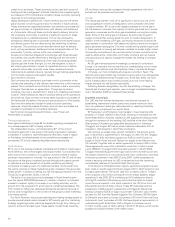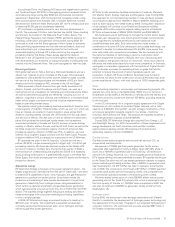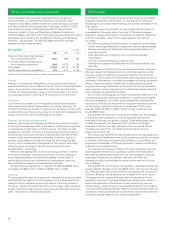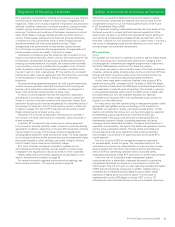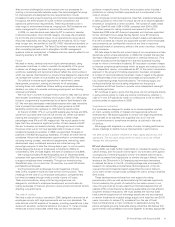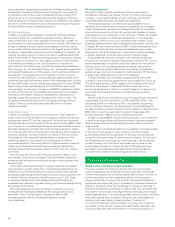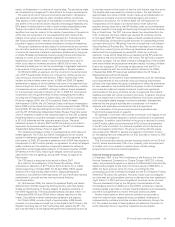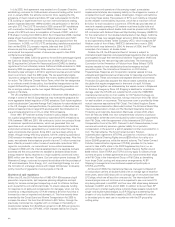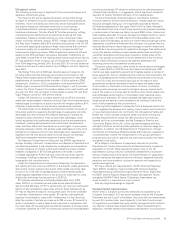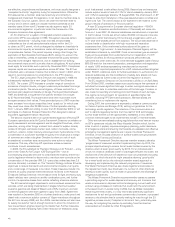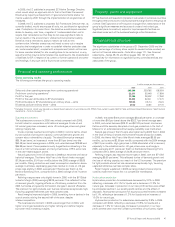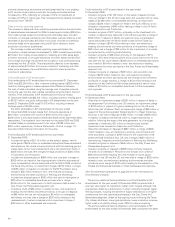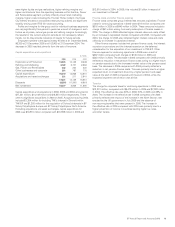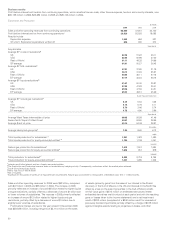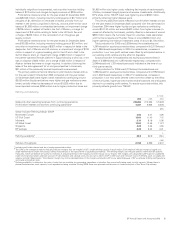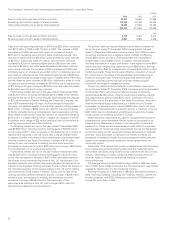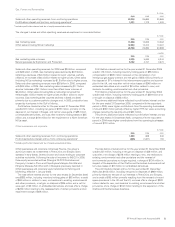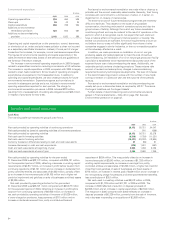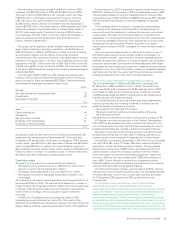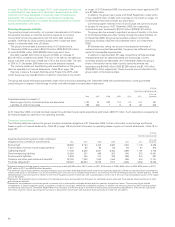BP 2006 Annual Report Download - page 48
Download and view the complete annual report
Please find page 48 of the 2006 BP annual report below. You can navigate through the pages in the report by either clicking on the pages listed below, or by using the keyword search tool below to find specific information within the annual report.are effective, proportionate and dissuasive, and must usually designate a
‘competent authority’ (regulatory body) for implementation. Where the
EC believes that a member state has failed fully and correctly to
transpose and implement EU legislation, it can take the member state to
the European Court of Justice, which can order the member state to
comply and in certain cases can impose monetary penalties on the
member state. A few non-EU states may also agree to apply EU
environmental legislation, in particular under the framework of the
European Economic Area agreement.
An EC directive for a system of integrated pollution prevention
and control (IPPC) was adopted in 1996. This system requires certain
industrial installations – including most activities and processes
undertaken by the oil and petrochemicals industry within the EU –
to obtain an IPPC permit, which is designed to address an installation’s
environmental impacts, air emissions, water discharges and waste in a
comprehensive fashion. The permit requires, among other things, the
application of Best Available Techniques (BAT), taking into account the
costs and benefits, unless an applicable environmental quality standard
requires more stringent restrictions, and an assessment of existing
environmental impacts and future site closure obligations. All such plants
must apply for and obtain such a permit by November 2007. Compliance
requires capital and revenue expenditure across BP sites. The EC has
embarked upon a process of review that is likely to report in 2007 and to
result in recommendations for amendments to the IPPC directive.
The EC Large Combustion Plant Directive was adopted in 1988 and
subsequently replaced by a new Large Combustion Plant Directive
in 2001. The current LCPD imposes a complex range of controls on
emissions of sulphur dioxide, nitrogen oxides and particulates from large
combustion plants. The nature and stringency of these controls for a
particular plant depend principally on its age. Plants permitted between
1987 and 2002 had a requirement for specific emission limit values
by 27 November 2002. Plants permitted since then must meet more
stringent emission limit values. Plants permitted prior to 1987 must also
meet emission limit values unless they have ‘opted out’ (in which case
they must now close after 20,000 hours of further operation starting
from 1 January 2008 and ending no later than 31 December 2015) or will
participate in a National Emission Reduction Plan designed to deliver
equivalent aggregate emission reductions.
The second important set of air quality-related legislation affecting BP
European operations is the Air Quality Framework Directive on ambient air
quality assessment and management and its daughter Directives, which
prescribe, among other things, ambient limit values for sulphur dioxide,
oxides of nitrogen, particulate matter, lead, carbon monoxide, ozone,
cadmium, arsenic, nickel, mercury and polyaromatic hydrocarbons. If the
concentration of a pollutant exceeds air quality limit values plus a margin
of tolerance set under a daughter Directive (or there is a risk of such
exceedance), a member state is required to take action to reduce
emissions. This may affect any BP operations whose emissions
contribute to such exceedances.
In 2005, the EC published its Thematic Strategy on Air Pollution – a key
part of the ‘Clean Air for Europe’ (CAFE
´)programme–andan
accompanying proposed directive to consolidate the existing ambient air
quality legislation referred to above and to introduce new controls on the
concentration of fine particles (PM 2.5 – particulate matter less than 2.5
microns diameter) in ambient air. The Thematic Strategy outlines EU-wide
objectives to reduce the health and environmental impacts of air quality
and a wide range of measures to be taken. These measures include: the
ambient air quality proposal mentioned above; revisions to the National
Emissions Ceilings Directive; new emission limits for light and heavy duty
diesel vehicles; new controls on smaller combustion plant; and further
control of evaporative losses from vehicle refuelling at service stations.
The EU has set stringent objectives to control exhaust emissions from
vehicles, which are being implemented in stages. Maximum sulphur
levels for gasoline and diesel of 50ppm and a 35% maximum aromatic
content for gasoline were both agreed to apply from 2005. Agreement
was reached in December 2002 on a further directive to make petrol and
diesel with a maximum sulphur content of 10ppm mandatory throughout
the EU from January 2009, and from 2005, member states will also have
to supply low-sulphur fuel at enough locations to allow the circulation of
new low-emission engines requiring the cleaner fuel. Further measures
on sulphur levels of shipping fuels and/or reduction of emissions using
such fuels started to take effect during 2006. Restrictions and measures
include sulphur levels in fuels of 0.1% for inland vessels by January 2010
and 1.5% for passenger ships by 19 August 2006. The chief impact on BP
is likely to arise from installation of flue gas desulphurization on ships and
higher cost fuel. The overall impact is not expected to be material to the
group’s results of operations or financial position.
A new EC programme for European chemical regulation – REACH
(Registration, Evaluation and Authorization of Chemicals) will come into
force on 1 June 2007. All chemical substances manufactured or imported
in the EU above 1 tonne per annum (about 30,000) will require a new pre-
registration within the following 18 months and a registration within a 3-
to 11-year time-phased period from adoption. The actual date depends on
volume bands or classification with high volumes and hazardous
substances first. Only time-limited authorizations will be given to
substances of ‘high concern’. A new European Chemical Agency will be
established in Helsinki by mid-2008. Crude oil and natural gas are exempt.
Fuels will be exempted from authorization but not registration. For BP,
REACH will affect all refining petroleum products, petrochemicals,
lubricants and other chemicals. An initial estimate suggests costs of about
$60,000 each for the internal preparation, pre-registration and registration
of nearly 1,000 entities representing manufactured or imported
substances or imported preparations for all BP individual entities obligated
under REACH. Additional costs for further submission to authorization for
relevant substances and the modification of safety data sheets will have
to be assessed as further costs once the final regulation is known.
The EC adopted a Directive on Environmental Liability on 21 April 2004.
From 30 April 2007, member states must usually require the operators of
activities that cause significant damage to water, ecological resources or
land after that date to undertake restoration of that damage. Provision is
also made for reporting and tackling imminent threats of such damage.
The regime is more stringent for operators of specified higher-risk
activities, including IPPC-permitted operations. Member states are
considering how to implement the regime.
During 2007, the commission is expected to release a communication
on Carbon Capture and Storage (CCS), setting out guidelines for the
technology and its regulation. The intention of the communication is in
part to identify regulatory barriers that may restrict CCS technologies,
so that those barriers can be appropriately addressed, and to identify
common methodologies to be implemented across EU member states.
Other environment-related existing regulations that may have an impact
on BP’s operations include: the Major Hazards Directive which, for the
sites to which it applies, requires emergency planning, public disclosure
of emergency plans and ensuring that hazards are assessed and effective
emergency management systems are in place; the Water Framework
Directive, which includes protection of surface waters and groundwater;
and the Waste Framework Directive.
The Water Framework Directive requires member states to develop
‘programmes of measures’ and start implementing them by 2012, the
principal objective being to ensure that all water bodies covered by the
directive attain at least ‘good quality’ by 2015. For an individual plant
which, for instance, abstracts water or discharges effluent into water, the
implications of the directive will depend on local circumstances (including
the extent to which the activity might prejudice attaining ‘good quality’
for a water body) and on the individual member state’s approach to
developing and implementing the relevant programme of measures.
The Water Framework Directive also draws together and provides for
the replacement (with new directives) of a number of other directives
relating to water quality, such as those on groundwater and discharge of
dangerous substances.
The Waste Framework Directive requires member states to operate
a permitting regime for waste disposal and recovery and to ensure that
waste is recovered or disposed without endangering human health and
without using processes or methods that could harm the environment.
A European Court of Justice ruling in 2004 (Van de Walle) interpreted
these requirements widely, in a way that raised potentially significant
implications for soil and groundwater contamination; however, a proposed
revision to the directive that is currently making its way through the EU
legislative process would, if adopted in its current form, potentially pave
the way for mitigating this position by excluding from the directive
unexcavated soil covered by other EU legislation.
46


